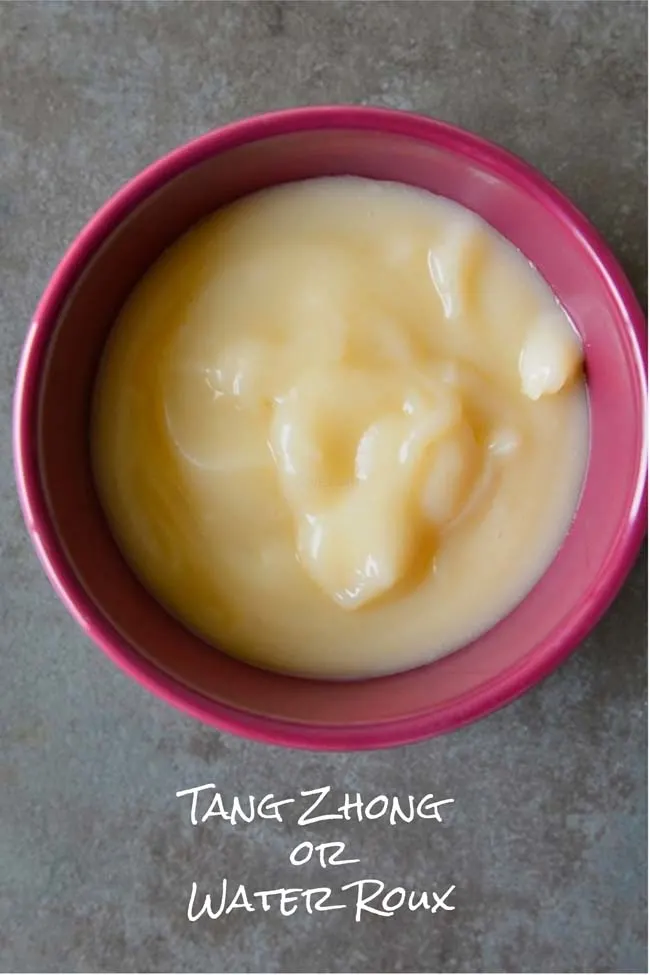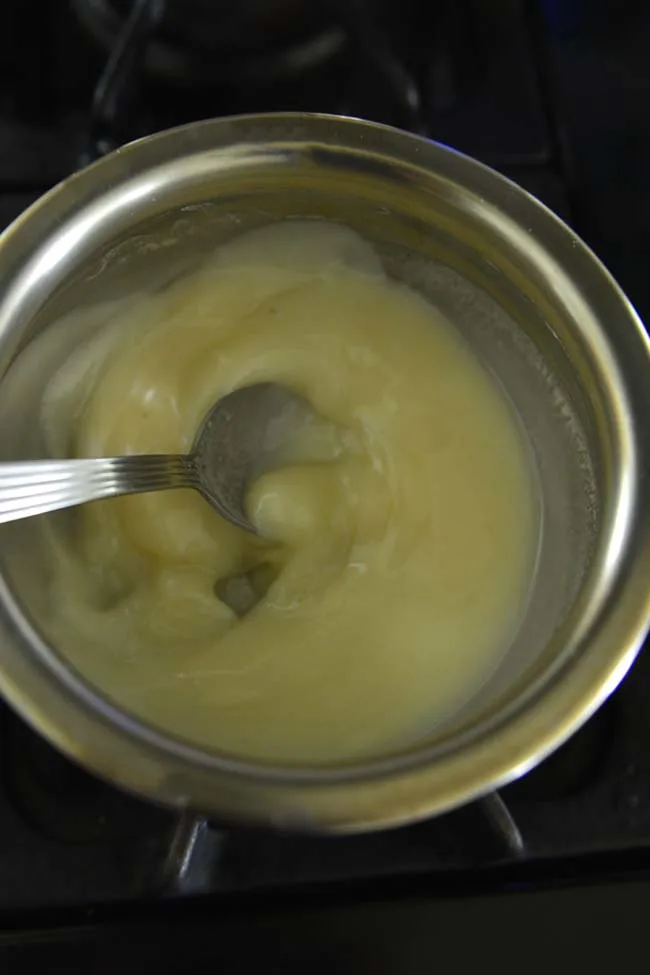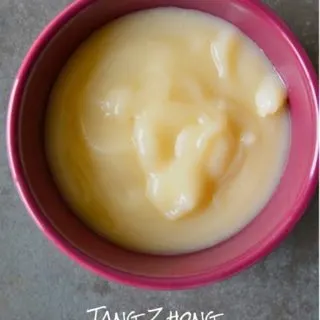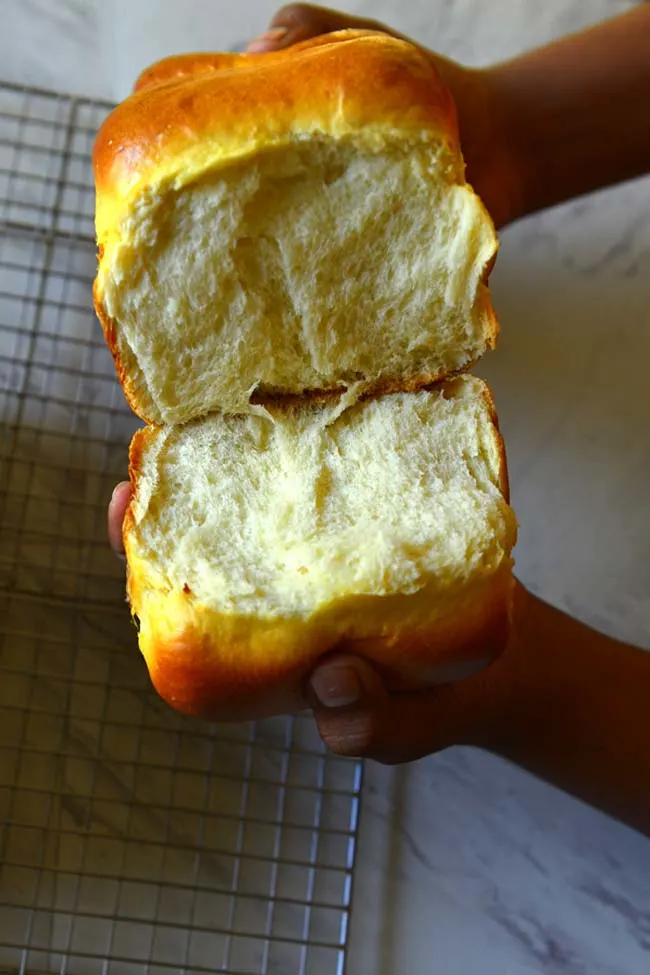Tangzhong or water roux is a cooked mix of flour and water used in breadmaking. It makes the bread softer and increases its shelf life.
Making breads with cooked starches is a common technique found around the world. It makes the bread softer and is of great importance when working with low gluten and gluten free flours. For example Jowar Roti and Ari Pathiri uses hot water to make soft flat breads with gluten flours. Tangzhong takes this technique a little further to create incredibly soft and spongy yeasted bread.

Contents
Jump to RecipeI fell in love with the pillow soft breads from the Asian bakeries years back. Most of the major Asian markets here have a bakery and restaurant attached, and the aromas wafting in the air are just incredible. They definitely knew how to lure the customers in!
What does that have to do with this custard looking thing, you ask? Well for ages I believed that these were made with dough conditioners and bleached flour and what not. Little did I know that they had a trick up the sleeve that made these breads soft as feather while keeping it preservative and chemical free!
What is Tangzhong?
This is that magic ingredient – a paste of liquid and flour known as Tangzhong. Tangzhong is a Japanese technique of cooking a small percentage of flour and liquid in the original recipe together until it thickens.
The mix of flour and liquid is cooked together till all the moisture is absorbed into the flour and thick gelatinous mix (roux) is formed. Generally flour can absorb more liquid when hot compared to room temperature. This means that the dough made with Tangzhong has higher percentage of water.
Unlike high hydration doughs (those pesky sticky ones you make for ciabatta or baguettes) this dough is easy to work with as the cooking has created a structure to retain the moisture. The moisture is contained within the dough and as a result creates wonderful oven spring as the dough bakes.
An added bonus is that these breads have a longer shelf life than their regular counterparts. This is good news for the baker. So if you have to serve the soft cinnamon rolls for breakfast you don’t have to wake up early in the morning and bake it fresh, because your Tangzhong cinnamon rolls will be soft and fluffy the next day as well!
Of course the smell of fresh baked cinnamon rolls have an additional advantage of making people get out of bread and into the kitchen! But then no one said you can’t make Tangzhong cinnamon rolls in the morning? – Go ahead make a double batch – these will stay soft and fresh for another 3 days …

How to Make Tangzhong
Making Tangzhong is an easy process. Here is how to do it
- Take 1 part flour and 5 parts of water or liquid to be used
- Mix well until no lumps remain
- Heat the mixture to 149°F or 65°C while stirring often
- Let it cool before adding to the bread dough
Most of the Tangzhong breads found in the market are made using the bread flour or all purpose flour. Though you can make it with whole wheat flour, the results have not been very spectacular. So if you plan on using this method to make whole wheat bread, make the Tangzhong using all purpose flour. It will not alter the nutritional value by much, but will increase the shelf life and create softer crumb.
The 1:5 ratio of flour to water is by weight. The approximate volume measurements are given in the recipe, but it is always better (and easier) to weigh the ingredients for bread.

Do I Need a Thermometer ?
The recipe calls for the mix to be heated to a specific temperature. If you have an instant read thermometer handy, this is a good time to use it. But there are other ways to determine when it reaches the right consistency.
The 65°C can be accurately predicted by looking at way the mix transforms while cooking. At this temperature the spoon that you have been using to stir the mix will start leaving a visible trail all the way to the bottom of the pan (pic). The consistency of the mix has changed into a thick paste and all the water is absorbed into the flour.
This is your cue to turn off the heat and transfer the contents to another dish, cover and let cool. The mix will not release water as it cools. Keep the Tangzhong covered as we do not want to dry it out. If not using the same day refrigerate it for 2 to 3 days.
Using Tangzhong in Bread Recipes
Converting regular bread recipe to use tangzhong
Tangzhong bread recipes use about 5% to 10% of the flour weight to make the roux. When you convert a bread recipe reduce both the flour and liquids by 5% (or up to 10%). Make tangzhong with the amount of flour reduced and add to the recipe.
Tips
- Adding more roux does not make the bread softer, instead the crumb becomes dense.
- For 100% whole wheat bread make the roux with AP/bread flour and reduce the flour used from the original recipe.
- Do not cook the dough more than 149°F / (65°C) a few degrees either way will not hurt. Cooking it more will dry out the roux and will not help it retain moisture.
- You can make the dough with the hot tangzhong (keep it below 10%), but do not add yeast directly on the hot tangzhong. Mix it in until the dough temperature is just warm and then add the yeast.

Basic Tangzhong
Ingredients
- 1/4 C Flour (30 g)
- 3/4 C Water (150 g)
Instructions
- Whisk the measured flour and water together in a heatproof dish . Make sure that there are no lumps . Transfer to stove top and heat at medium heat stirring continuously .
- Once the mixture is heated to 149°F or 65°C ( the spoon starts leaving trails reaching the bottom of the pan as you stir ) turn the heat off .
- Transfer to a dry bowl and cover tightly with a plastic wrap or a tight lid . Cool to room temperature .
Notes
- Up to 10% by weight of the flour in the original recipe can be used to make tangzhong.
- Do not over cook – the mix loses it elasticity and does not retain moisture when overcooked.
- 1 : 5 ratio of flour to liquid is used to make tangzhong.
Important: Nutrition Values are estimates. Actuals vary based on ingredients and serving size.

Here is a recipe Tangzhong – Hokkaido Milk bread
Interested in Bread Recipes – Try These
- Herman Milk Bread
- Kulich – Russian Easter Bread
- Himbasha – Ethiopian Bread
- Monkey Bread
- Olive Bread
- Pao buns
- All Bread recipes
Originally published on Nov 13, 2015. Updated content and images


Laarni
Monday 29th of November 2021
Hi!Can I use full cream or fresh milk instead of water in making this Tangzhong mixture?thank you ..
Syama
Tuesday 7th of December 2021
Cream has a much higher percentage of fat compared to water or even milk. I would recommend using milk instead of cream.
Okami
Thursday 10th of June 2021
I want to use milk and water in my tangzhong, how much of each should i use?
Syama
Thursday 10th of June 2021
Hi, I would say consider water and milk as equals in this recipe. There will be a little less moisture in the milk (due to protein, fat etc.) but it will not be significant enough change the effect of using Tangzhong. Also consider this, unlike water all milk are not created equal. So an exact conversion amounts will differ slightly based on the actual products used. If you are experimenting or tying to fine tune a recipe use the above as the starting point and adjust the ratios as needed. - Syama.
Thanks
Tuesday 25th of May 2021
(TangZhong is Chinese)
Anieta
Tuesday 4th of May 2021
can we use tangzhong for cakes too ?
Syama
Saturday 8th of May 2021
No, there is a cooked roux method for making cakes, but it is not tangzhong.
Dave
Wednesday 21st of April 2021
Yeast dies at 59°C (138°F) Keep liquid temperatures around 41-46°C (105-115°F).
Dave
Saturday 24th of April 2021
@Syama, I was simply expanding on the danger of adding too hot of a tangzhong mixture into the yeasted dough and killing some, but not all, of the yeast. Proofing yeast in a warm liquid requires the same attention. It's a little bit of information is all. Cheers....
Syama
Wednesday 21st of April 2021
@Dave, I fail to see how this is relevant here? Care to elaborate?